Depending on activity, location, and habitat, outdoor workers can encounter mosquitoes and should take precautions to minimize bites. Over 3,500 types of mosquitoes live worldwide, with over 180 in the U.S. According to the CDC, from 2004 to 2018, an average of 5,328 mosquito-borne disease cases occurred in the U.S. each year, with roughly 200 annually in Illinois, despite robust mosquito-control efforts. Worldwide, nearly 700 million people are infected with a mosquito-borne illness, resulting in over one million deaths each year. Due to the difficulty of identifying infected mosquitoes, it is important to protect yourself from bites.
Health Risks of Mosquito Bites
(According to the CDC and Mayo Clinic)
When a mosquito bites, it injects saliva containing an anticoagulant that ensures a steady flow of blood. The body reacts to the saliva resulting in a bump and itching that typically resolves in a few days. However, severe reactions can occur in people with immune system disorders and those allergic to mosquito saliva. If you tend to have severe reactions to mosquito bites, consider taking a non-drowsy, over-the-counter antihistamine when you may be exposed to mosquitoes. In addition, some mosquitoes can become vectors when they are infected with a pathogenic disease agent (e.g., West Nile virus) after biting an infected animal and then transmit the disease agent to humans through their bite, causing a vector-borne disease.

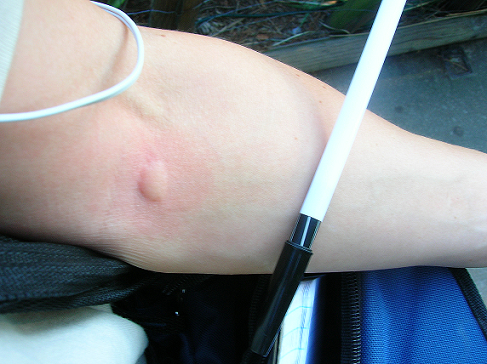
Mosquito bites by Andrew Mackay, INHS. Mosquito bite wheal on the inside forearm by Holly Tuten, INHS
| Symptoms | Treatment | |
|---|---|---|
| Mild Reaction |
|
|
| Severe Reaction |
| |
| Bacterial infection from scratching |
| |
| Vector-borne diseases from an infected mosquito bite | Symptoms | Treatment |
|---|---|---|
| Symptoms vary by disease but commonly include:
| See a doctor at the first signs of symptoms and let them know if you have traveled outside the state recently. |
Common Mosquito Species in Illinois
Be sure to research mosquito species you may encounter when working outside of Illinois.
Asian Bush Mosquito (Aedes japonicus)
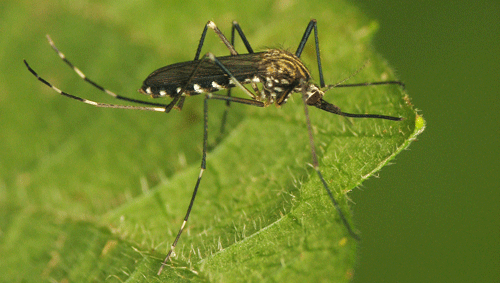
Aedes japonicus by Sean McCann, Simon Fraser University. 
Behavior and Breeding Sites: Day-biting species. Females lay their eggs on shaded container walls above water rich in organic matter, including natural (stone, tree holes, bamboo, ground pools) and artificial containers (pots).
Associated Diseases: Japanese Encephalitis (native range); unclear to what extent it is involved in transmission of arboviruses in the United States. Has been shown to be capable of transmission in the lab of West Nile virus disease, St. Louis Encephalitis, Eastern Equine Encephalitis, La Crosse Encephalitis, and Rift Valley fever virus.
Asian Tiger Mosquito (Aedes albopictus)
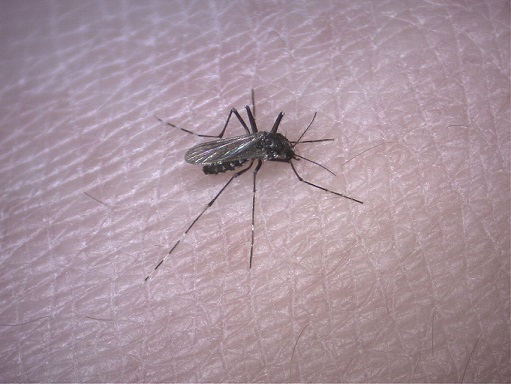
Aedes albopictus by Corrado Cara and Lewis Greenstein, INHS.
Behavior and Breeding Sites: Very aggressive day-biting species (peaks during early morning and late afternoon), abundant in forest and urban environments. Females lay their eggs just above the waterline in natural (tree cavities) and artificial containers (tires, gutters, water collections in garden environments) that hold water.
Associated Diseases: Chikungunya virus disease, Dengue, Zika virus disease; a range of viruses has been detected in this species, including Eastern Equine Encephalitis, La Crosse Encephalitis, and West Nile virus disease, but its role in their transmission in the United States remains unclear.
Cattail Mosquito (Coquillettidia perturbans)
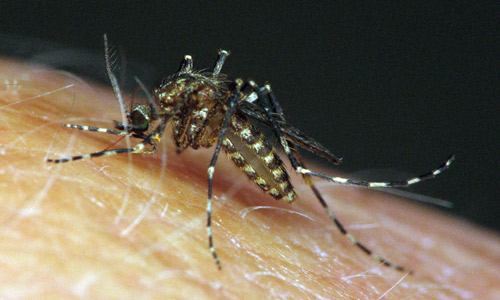
Coquillettidia perturbans by Sean McCann, Simon Fraser University.
Behavior and Breeding Sites: Bite in the early evening but will bite in the daytime if disturbed while resting in shady areas. Females lay their eggs on the surface of the water near the leaves of emergent aquatic vegetation.
Associated Diseases: Bridge vector for Eastern Equine Encephalitis and Jamestown Canyon virus disease.
Eastern Treehole Mosquito (Aedes triseriatus (Ochlerotatus triseriatus))
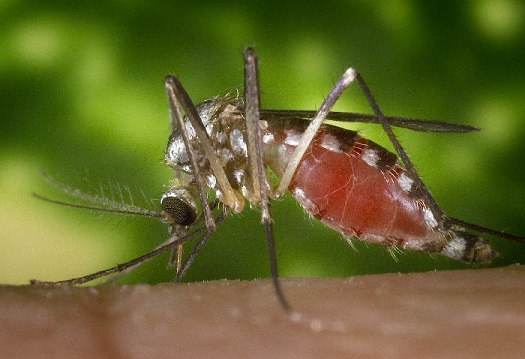
Aedes triseriatus by James Gathany/CDC
Behavior and Breeding Sites: Day-biting species. Females lay their eggs just above the waterline in containers that hold water. Most commonly in cavities of trees, stumps, tires, buckets, etc.
Associated Diseases: La Crosse Encephalitis.
Inland Floodwater Mosquito (Aedes vexans)


Behavior and Breeding Sites: Active in late afternoon and after dark, but will bite any time of day if disturbed while resting in shaded, heavily vegetated areas. One of the first mosquitoes noticed in the spring after heavy rainfall and considered the most prevalent mosquito in Illinois. Females lay their eggs in soil that becomes flooded, most commonly in temporary, rain-filled habitats, such as ditches, detention basins, woodland pools, floodplains, etc.
Associated Diseases: Primarily a nuisance biter.
Northern House Mosquito or Common House Mosquito (Culex pipiens)
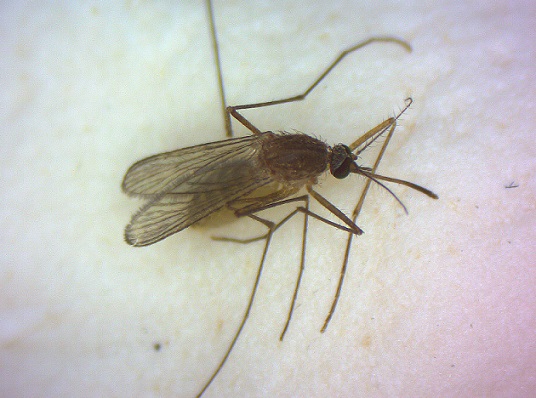
Culex pipiens by Lewis Greenstein, INHS.
Behavior and Breeding Sites: Bites from dusk to dawn. Females lay rafts of eggs on the surface of clean or polluted stagnant water in natural and artificial aquatic habitats in heavy shade and full sun. Commonly in tree holes, ponds, ditches, catch basins, sewage water, non-chlorinated pools, gutters, tires, pots, etc.
Associated Diseases: St. Louis Encephalitis, West Nile virus disease.
Psorophora ciliata Mosquito

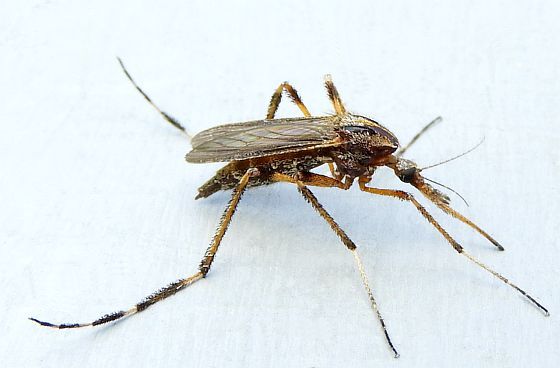
Psorophora ciliata by Jim Eckert.
Behavior and Breeding Sites: The largest mosquito in North America that bites any time of day. Females lay their eggs in unshaded, low-lying areas with damp soil and grassy overgrowth, including small ground depressions and potholes.
Associated Diseases: Primarily a nuisance biter.
White-spotted Mosquito (Culex restuans)
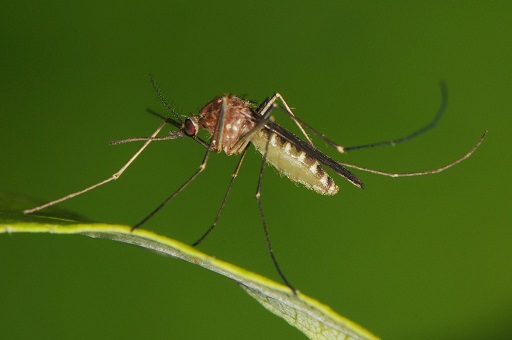
Culex restuans by Jason M Crockwell / CC BY-NC-ND 4.0.
Behavior and Breeding Sites: Bites from dusk to dawn. Females lay their eggs on the surface of stagnant water. Most commonly in catch basins, polluted water, tires, and ditches.
Associated Diseases: St. Louis Encephalitis, West Nile virus disease.
Woodland Pool Mosquito (Aedes canadensis)


Aedes canadensis by Dr. Gary Alpert/CDC.
Behavior and Breeding Sites: Day biting mosquito. Females lay their eggs at the edge of woodland pools.
Associated Diseases: Eastern Equine Encephalitis, Jamestown Canyon virus disease, La Crosse Encephalitis.
Mosquito Bite Prevention
- Know when to expect mosquitoes
- In Illinois, mosquito season starts in the spring and runs through the autumn until the first hard frost.
- Mosquitoes are most active dusk to dawn; however, some species feed during daylight hours.
- Know where to expect mosquitoes
- Mosquitoes thrive in warm, humid environments; however, they can be found virtually anywhere in Illinois.
- Mosquito habitats range from dense urban areas to forests, marshes, and grasslands.
- Know how mosquitoes find you
- Mosquitoes detect exhaled breath (carbon dioxide), body chemicals (i.e., lactic acid in sweat), body care products, dark colors, and heat to find a host.
- Only female mosquitoes bite to get a blood meal to produce eggs.
- Know what repellents to use
- See Repellent Options and Application Guidance to learn what repellents to use and how to apply them.
- Use EPA-registered insect repellents on skin.
- Apply only the label-recommended amount of repellents.
- Treat clothing and gear with products containing 0.5% permethrin.
Warning: Wet permethrin is toxic to cats, fish, aquatic invertebrates, bees, and other beneficial insects.
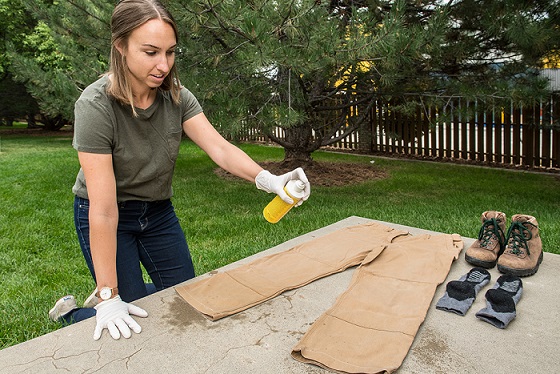
Woman applying permethrin to her pants and outdoor clothing. Credit: CDC.
- Know what to wear
- Dark colors and dark visual contrast attract mosquitoes, so wearing light-colored no-contrast clothing may be beneficial.
- Wear loose-fitted long-sleeved shirts and long pants made of tightly woven materials to keep mosquitoes away from the skin.
- Tuck pant legs into boots or socks.
- For extra protection, wear a hat that protects your ears and neck, a hat with mosquito netting that covers your face, or consider mosquito net clothing.
- Avoid wearing cologne, perfume, or scented lotions.
- Know how to limit exposure to mosquitoes
- When possible, avoid outdoor activities where and when mosquitoes are most active.
- Add mosquito netting to unscreened structures.
- Remove and prevent standing water in artificial containers (i.e., bins, uncovered equipment, tarps, etc.).
Resources
- Caraballo H, King K. Emergency department management of mosquito-borne illness: malaria, dengue, and West Nile virus. Emergency Medicine Practice. 2014 May;16(5):1-23; quiz 23-4. PMID: 25207355. https://www.ebmedicine.net/topics/infectious-disease/mosquito-borne
- CDC – Division of Vector-Borne Diseases: https://www.cdc.gov/ncezid/dvbd/vital-signs/index.html
- CDC – Mosquitoes: https://www.cdc.gov/mosquitoes/index.html
- CDC Newsroom – Mosquito Bites: Everyone is at Risk!: https://www.cdc.gov/media/dpk/diseases-and-conditions/mosquito-borne-diseases/index.html
- CDC-NIOSH – Mosquito-Borne Diseases: https://www.cdc.gov/niosh/topics/outdoor/mosquito-borne/default.html
- Dymond, NL, Swift, IM Permethrin toxicity in cats: A retrospective survey of 20 cases. Aust Vet J 2008; 86: 219-23. https://onlinelibrary.wiley.com/doi/full/10.1111/j.1751-0813.2008.00298.x
- IDPH – Structural Pest Control: https://www.dph.illinois.gov/topics-services/environmental-health-protection/structural-pest-control
- Illinois Environmental Protection Agency – Mosquito-Borne Illnesses: https://www2.illinois.gov/epa/topics/waste-management/illegal-dumping/used-tires/Pages/mosquito-borne-illnesses.aspx
- Illinois News Bureau – Asian tiger mosquito gains ground in Illinois: https://news.illinois.edu/view/6367/809351
- Illinois News Bureau – Does more rain mean more risk of mosquito-borne diseases in Illinois?: https://news.illinois.edu/view/6367/799466
- Kampen, H., Werner, D. Out of the bush: the Asian bush mosquito Aedes japonicus japonicus (Theobald, 1901) (Diptera, Culicidae) becomes invasive. Parasites Vectors 7, 59 (2014). https://doi.org/10.1186/1756-3305-7-59
- Liu MZ, Vosshall LB. General Visual and Contingent Thermal Cues Interact to Elicit Attraction in Female Aedes aegypti Mosquitoes. Curr Biol. 2019 Jul 8;29(13):2250-2257.e4. doi: 10.1016/j.cub.2019.06.001. Epub 2019 Jun 27. PMID: 31257144. https://www.sciencedirect.com/science/article/pii/S0960982219306943#bib6
- Mayo Clinic: https://www.mayoclinic.org/diseases-conditions/mosquito-bites/symptoms-causes/syc-20375310
- NPIC – Permethrin Technical Fact Sheet: http://npic.orst.edu/factsheets/archive/Permtech.html
- Pests.org – 2021 Mosquito Forecast: https://www.pests.org/mosquito-forecast/
- UF|IFAS – Culicidae: https://entnemdept.ufl.edu/creatures/main/search_higher_insects.htm
- Walter Reed Biosystematics Units (WRBU) – Mosquitoes: https://wrbu.si.edu/vectorspecies